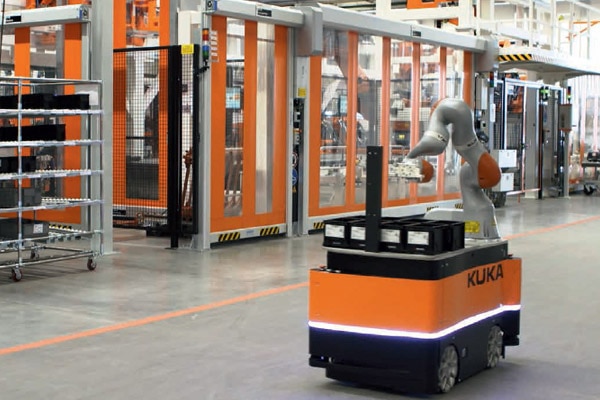Industrial production in the future will see us working with assistants that are modular, versatile and, above all else, mobile. In KMR iiwa, KUKA Roboter GmbH has developed a fully automated, autonomous solution that combines the LBR iiwa lightweight robot and the OmniMove mobile platform. KUKAs long-standing partnership with SICK has played an integral role in the process, thanks to safety laser scanners that provide both a protective function and navigational support in the KMR iiwa. This enables the worker to interact directly with the robot, which moves autonomously. No physical guards are required, making this system genuinely true to the spirit of creating sustainable flexibility in production.

The ability of mobile robots to move independently through factory halls and transport goods or workpieces represents the future of logistic processes in production. For the robot manufacturer KUKA, the future is already here. In its production workflow, the KMR iiwa picks boxes containing materials and delivers them to the production line as and when they are needed. It shares the routes it travels, as well as the shelving areas, with tugger trains and workers. KUKAs new materials are ordered automatically through its ERP systems and suppliers - a practice that lines up with the principles of Industry 4.0 - and are then distributed among workstations by the KMR iiwa, entirely autonomously. However, the companys focus is on more than just the production skills the robot offers in-house. The KMR iiwa offers all kinds of application possibilities, says Peter Gmeiner from Industrial Business Development, Mobile Robotics at KUKA. These range from fetch-and-carry services to roles in producing small quantities at multiple workstations, all the way through to complex, flexible production workflows in the automotive and electronics industries. Combining the sensitivity of the LBR iiwa with the mobility of the KMR iiwa also opens up the potential to add real value to quality assurance processes.
A significant challenge for navigation and safety
 With the KMR iiwa, KUKA is combining the strengths of the sensitive LBR iiwa lightweight robot with a mobile and autonomous platform. Pictures: KUKA Roboter GmbH
With the KMR iiwa, KUKA is combining the strengths of the sensitive LBR iiwa lightweight robot with a mobile and autonomous platform. Pictures: KUKA Roboter GmbH
For some years now, KUKA has already been successfully integrating SICK solutions into its OmniMove heavy-duty platform. These vehicles are able to move up to 90 tonnes and work on the basis of interaction between the S3000 safety laser scanner from SICK and KUKA navigation software. When the KMR iiwa was being developed, it was essential to find exactly the right technology for the job, plus excellent application knowledge and in-depth cooperation with a technology partner. It therefore became another application with equipment from SICK, this time using a pair of more compact S300 safety laser scanners. The 270° scanning angle of these devices ensures all-round surveillance. Multiple protective fields that offer flexible configuration options are especially important in applications that use compact, mobile robots - and the 16 freely configurable protective fields offered by the S300 allow flexible adaptation to a range of traveling situations and environmental conditions. Mobile robotics also require vehicles that are as compact and rugged as possible, and have to consider the amount of energy that components consume. Its small size means that the S300 offers the right technical credentials in this respect too, and this made it one of the key building blocks in creating a solution to suit KUKAs needs.
Scanner data for autonomous Navigation
 More than just protection: The S300 safety laser scanner
More than just protection: The S300 safety laser scanner
So how does the KMR iiwa receive control signals for moving to a position - in other words, how does its autonomous navigation work? To achieve this, the KUKA navigation software uses information including data supplied by the safety laser scanner from SICK. This means that the S300 provides more than just straightforward protection. The navigation software continually evaluates the distance measurements taken by the safety laser scanner. It then uses this information to create a kind of map of the environment and determine the KMR iiwas position within these coordinates, explains Klaus Mattuschat, who heads up the OmniMove team in Mobile Robotics at KUKA. Objects that are always found at the same point, like pillars in the hall or fixed parts of plants, are interpreted as established reference points. However, moving objects or objects that undergo dynamic changes are ignored, so to speak. In most cases, the KMR iiwa either moves along defined paths from one specific point to another, or it navigates freely. Its able to avoid objects that are in its way by itself.
Safety for mobile industrial robot
One of the most significant challenges facing mobile robotics is how to design systems in a way that accommodates what the applicable standards specify: for example, EN ISO 10218 Parts 1 and 2. The technical specifications of ISO/TS 15066 also apply to collaborative systems in particular. In addition to system design requirements, an individual risk assessment conforming to EN ISO 12100 must be carried out for each KMR iiwa application. This is an all-encompassing risk analysis that sees KUKA working in close collaboration with customers and/or system integrators.
Mobile systems: A cornerstone of the intelligent factory
The intelligent factory concept envisages individual production elements being networked with one another during production. This requires the data that is captured, evaluated, and transmitted by sensors to be reliable. Maintaining transparency at all stages of the production and logistics chain is crucial for this data. It is not just data networking that is important, however: Mobile systems like the KMR iiwa provide a link between individual stages of work, especially in automated and networked production environments. They represent a new form of mobility - one that also relies on innovative solutions to protect humans and materials.
- Product information: S300 safety laser scanners
- More information: KUKA Roboter GmbH


